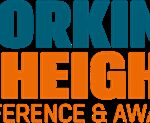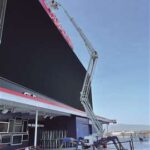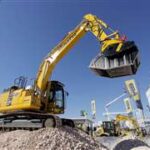Not every job is a wide-open parking lot.
Sometimes, you need to reach over pipes, duck under beams, swing around obstacles, and still land the perfect spot.
That’s when you call in the true aerial ninja:
The articulating boom lift.
Let’s get to know why this flexible powerhouse is the unsung hero on job sites everywhere.
🧠 What Exactly Is an Articulating Boom Lift?
An articulating boom lift (also called a knuckle boom) has multiple boom sections connected by joints.
These joints bend—like elbows—giving the machine the ability to reach up, over, around, and into tough-to-access spaces.
Imagine a scissor lift had a baby with an octopus.
That’s the maneuverability you’re getting.
📈 How They Move Differently
Compared to straight (telescopic) booms that extend in one long line, articulating booms:
-
Rise vertically
-
Bend at multiple points
-
Swing horizontally in tight radii
-
Sneak into awkward spaces other machines can’t even dream of
They aren’t about distance—they’re about precision.
🏗️ Best Use Cases for Articulating Boom Lifts
-
Indoor construction (factories, malls, warehouses)
-
Tight urban sites (think alleyways and parking decks)
-
Facility maintenance (schools, airports, hotels)
-
Stadium work (under rafters, over seating)
-
Tree trimming (reaching around massive trunks)
If your project involves obstacles, height variation, or limited movement space, articulating booms are your go-to gear.
📏 Typical Specs
| Specification | Typical Range |
|---|---|
| Working Height | 30 ft to 150 ft |
| Horizontal Outreach | 20 ft to 70 ft |
| Platform Capacity | 500 lbs (2 workers + tools) |
| Power Sources | Diesel, electric, hybrid |
| Indoor/Outdoor Usage | Both (with electric models) |
Popular models:
-
Genie Z-45/25J RT
-
JLG 800AJ
-
Haulotte HA16 RTJ PRO
⚡ Electric vs Diesel Articulating Booms
Electric Articulating Booms (e.g., Genie Z-34/22N):
-
Zero emissions
-
Super quiet
-
Ideal for indoor use
Diesel Articulating Booms (e.g., JLG 600AJ):
-
Greater power for rough terrain
-
Longer runtime
-
Outdoor champions
Hybrids (like Genie FE series) give you a bit of both, flexibly switching between clean indoor and dirty outdoor work.
🌟 Why Contractors Love Articulating Booms
✅ Obstacle dodging: Pipes, HVAC ducts, tree branches—no problem.
✅ Compact setup: Fits into tighter areas than straight booms.
✅ Versatile: Indoor and outdoor versions available.
✅ Efficiency booster: Save hours avoiding scaffold rebuilds or repositioning.
✅ Safety friendly: Safer access to hard-to-reach spots with minimal repositioning.
⚠️ Things to Watch Out For
-
Lower horizontal outreach than telescopic booms.
-
Slightly slower lift times due to multiple joints moving.
-
Higher complexity = more components to maintain.
(That said, modern designs are surprisingly low-fuss.)
💡 Pro Tips for Maximizing Articulating Booms
-
Plan your swing path: Articulating arms need breathing room.
-
Check tilt sensors: Stability matters, especially with multiple moving joints.
-
Battery care is crucial for electric models—charge fully and regularly.
-
Train operators on platform control nuances (they’re smooth but different from straight booms).
🏁 Final Thoughts
If straight booms are the freight trains of the aerial world,
then articulating booms are sports cars with wings.
They’re agile, adaptable, and absolutely critical when access gets tricky.
So next time you’re staring at a ceiling duct 35 feet up, wrapped behind a steel beam and under a water pipe,
don’t panic.
Call for an articulating boom.
It’ll reach what scaffolding, ladders, and prayers simply can’t.




